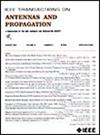A Cross-Type Multifocus Phase Compensation Method Enables Metalens Antenna Wide-Angle Beam Steering
IF 5.8
1区 计算机科学
Q1 ENGINEERING, ELECTRICAL & ELECTRONIC
引用次数: 0
Abstract
An artificial metalens manipulates the electromagnetic wavefront phase via deploying transmitted phase and amplitude of metasurfaces units, which exhibits excellent merits in beam steering application. The metalens with single-focus phase distribution can only compensate for the first-order Taylor expansion of the outgoing beam by modulating the wavefront phase entering the lens surface, resulting in a very limited beam scanning range, and the phase error dramatically increases with the beam steering to the large angles, which suffers serious gain degradation. We, herein, proposed a novel cross-type multifocus phase compensation method to modulate the wavefront phase and increase the proportion of transmitted phase linear term to enlarge the beam steering angle. Three-focus and five-focus lenses are implemented based on the proposed phase distribution method and extend the beam scanning angle to ±48° and ±71° with a gain degradation of only 3.8 dB, respectively. A three-focus metalens is designed by employing three-bit phase-quantized metasurface units and simulated with commercial software CST Microwave Studio. The metalens operates in the frequency range of 24.25–25.8 GHz. It is capable of steering the main beam from −48° to 48° with gain degradation of 3.8 dB. The three-focus metalens is fabricated and measured, and the experimental results match well with simulated ones, which validates the efficacy of the proposed multifocusing method. Meanwhile, the influence of amplitude and phase errors of the metasurface units on the metalens performance is analyzed to fully evaluate the metalens antenna and illustrate the robustness of the proposed method.一种十字型多焦点相位补偿方法实现超透镜天线的广角波束控制
人工超构透镜通过部署超表面单元的透射相位和幅值来控制电磁波前相位,在波束转向应用中表现出优异的优点。单焦点相位分布的超透镜只能通过调制进入透镜表面的波前相位来补偿出射光束的一阶泰勒展开,导致光束扫描范围非常有限,并且随着光束转向大角度,相位误差急剧增加,增益下降严重。本文提出了一种新的交叉型多焦点相位补偿方法,通过调制波前相位,增加传输相位线性项的比例来增大波束转向角。基于所提出的相位分布方法实现了三焦和五焦透镜,将光束扫描角扩展到±48°和±71°,增益衰减仅为3.8 dB。采用三比特相位量子化超表面单元设计了三焦超透镜,并利用商用软件CST Microwave Studio进行了仿真。超构透镜的工作频率范围为24.25-25.8 GHz。它能够将主波束从- 48°转向到48°,增益衰减为3.8 dB。制作并测量了三焦超构透镜,实验结果与仿真结果吻合较好,验证了多焦方法的有效性。同时,分析了超表面单元的幅值误差和相位误差对超表面天线性能的影响,充分评价了超表面天线的性能,验证了所提方法的鲁棒性。
本文章由计算机程序翻译,如有差异,请以英文原文为准。
求助全文
约1分钟内获得全文
求助全文
来源期刊
CiteScore
10.40
自引率
28.10%
发文量
968
审稿时长
4.7 months
期刊介绍:
IEEE Transactions on Antennas and Propagation includes theoretical and experimental advances in antennas, including design and development, and in the propagation of electromagnetic waves, including scattering, diffraction, and interaction with continuous media; and applications pertaining to antennas and propagation, such as remote sensing, applied optics, and millimeter and submillimeter wave techniques

 求助内容:
求助内容: 应助结果提醒方式:
应助结果提醒方式:


